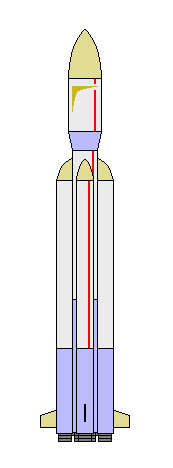IB Turkestan
Launch Systems: Mıtra

The Persia-based rocket development team selected a different member of the Aldaspan series for modification, the single-stage Aldaspan-6. The single stage of the Aldaspan-6 is larger than either of the stages of the Aldaspan-7, however, and the Persia team supplemented this lifting capacity by the addition of several strap-on solid-fuel boosters. This is a more brute-force approach than the Turkestani team has been using, though it appears to have the advantage of being adaptable to multiple payload requirements:- Need to lift a heavier payload? Just add more boosters.
The Persia-based team completed their modifications and testing of their Mıtra (after the Zoroastrian fire and solar spirit) rocket only 4 days before the Turkestan team's Aruana rocket launched the Dostlik satellite. Mıtra was used to launch the follow-up satellite Beybit on 3- Mizäm (3rd June), Buqa jıl 2009.
Specifications:

Mıtra launch rocket
Height: 29 arçın 4 süyüm (20.8m)
Diameter (core stage): 1 qulaş (5'-6" / 1.67m)
Diameter (booster): 6 süyüm 3 iliş (85.5cm)
Propellants: N-stoff/B-stoff (core stage); K-stoff (boosters)*
Stages: 1, plus 2-6 strap-on solid-fuel boosters
Lifting capacity: Unclear; probably in the range of 1,000-1,500 lb to low Earth orbit
*Propellants: IB's rocket engineers use German-derived designations for the various fuels and oxidisers available. The core stage's N-stoff/B-stoff combination is Nitrogen Tetroxide and Hydrazine, while K-stoff is the solid propellant Methylchloroformate.
Diameter (core stage): 1 qulaş (5'-6" / 1.67m)
Diameter (booster): 6 süyüm 3 iliş (85.5cm)
Propellants: N-stoff/B-stoff (core stage); K-stoff (boosters)*
Stages: 1, plus 2-6 strap-on solid-fuel boosters
Lifting capacity: Unclear; probably in the range of 1,000-1,500 lb to low Earth orbit
*Propellants: IB's rocket engineers use German-derived designations for the various fuels and oxidisers available. The core stage's N-stoff/B-stoff combination is Nitrogen Tetroxide and Hydrazine, while K-stoff is the solid propellant Methylchloroformate.
